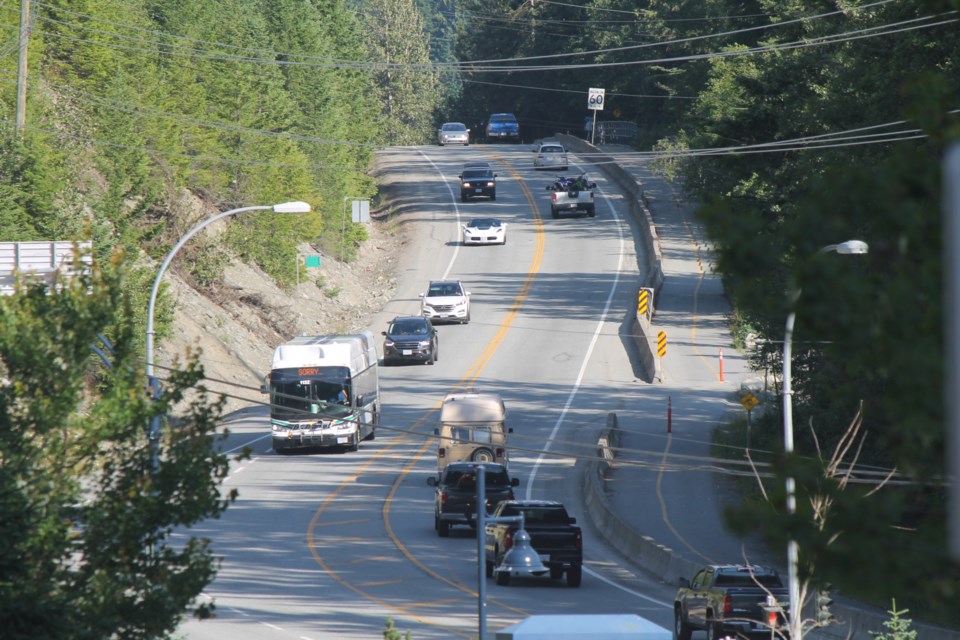A long-awaited provincial review of capacity and safety issues on Highway 99 through Whistler identifies some potential solutions—but with little appetite for funding, the Resort Municipality of Whistler (RMOW) is instead eyeing transit gains and short-term wins.
The review—conducted by McElhanney Ltd. at the expense of the provincial Ministry of Transportation and Infrastructure (MOTI)—lays out short-, medium- and long-term options for highway improvements.
The study considered options like a dual westbound left turning lane at Lorimer Road (shorter-term); counterflow lanes that could shift north or south depending on traffic volumes (medium); two southbound lanes from Taylor Way to Bayshore Drive, or Alpha Lake Road (medium); or two southbound lanes from Lorimer to Alpha Lake Road (long-term).
Cost estimates for the various options range from about $405,000 for the dual left turning lane at Lorimer to more than $60 million for a full twinning of the highway in Whistler.
After evaluating the options based on cost, safety, traffic operations, driver experience, environmental impact and more, McElhanney recommended the improvements at Lorimer be considered, and that southbound lanes from Taylor Way to Alpha Lake Road are also viable, subject to funding.
“It is recommended that MOTI conduct additional analysis and design to determine the most appropriate medium-term option,” the report states, adding that MOTI should also further study the feasibility of the long-term option.
But according to the ministry’s own criteria, “none of these options that they actually reviewed came up as a particularly high benefit-cost ratio; none of them come out clearly as a project that sort of should be done right away,” said general manager of infrastructure James Hallisey.
“So that led RMOW staff to suggest we also need to embed some smaller projects into this report … We need to have some other options where we can step forward in a meaningful way by taking some smaller steps.”
As such, RMOW staff are currently in discussions with MOTI about pedestrian safety upgrades at four key locations along Highway 99, Hallisey said: Whistler Road (through to Whistler Creekside); Meadow Lane; Autumn Drive/Emerald Drive; and Route 10-Valley Express bus stops.
Other trouble spots can be identified by the municipal Transportation Advisory Group as necessary, he added.
The report is mostly focused on southbound traffic on a peak winter Sunday, noted Councillor Cathy Jewett, adding that improving the flow of traffic to the north is key as well.
And with so much housing going up or planned for Cheakamus Crossing, “I was really hopeful that we were going to see some more ideas about the transit queue jumper, and improving transit movement,” Jewett said.
The report does contain good info about potentially using the highway shoulder for traffic, Hallisey noted, which would be relatively easy to implement for transit.
“That is the idea that staff has been pursuing and will continue to push along, because that looks to have some real benefits,” he said.
“And if our buses can be bypassing traffic congestion, you know our ridership is only going to increase.”
As for who would pay for such upgrades, “it’s a joint project,” said transportation demand management coordinator Emma DalSanto.
The RMOW does have some developer contributions to be used for transit improvements, which puts it ahead of the game in some respects, but the funds alone aren’t enough to pay for a project.
“There are various funding programs out there to do some cost-sharing or to apply for grants,” DalSanto said.
“At this point, we’ve talked about doing some design work with some RMOW funds, but when it comes to actually building things, it would be up for discussion.”
Coun. Arthur De Jong wondered about the long-term future of transportation to and through Whistler, with rapid advancements of technology predicted alongside burgeoning populations.
“How far should we be looking to try and anticipate the many changes coming at us?” De Jong asked.
Transportation will look very different in the next 15 to 30 years, Hallisey agreed, as technological solutions like autonomous vehicles may make things like congestion and timing issues a thing of the past.
“But in the meantime, we need to be planning for what can we do in the more short-term, and definitely getting more people into more transit and buses is an obvious win,” he said.
“And we’ve already proven that to be successful, so that’s definitely the thing we need to keep our eye on here.”




